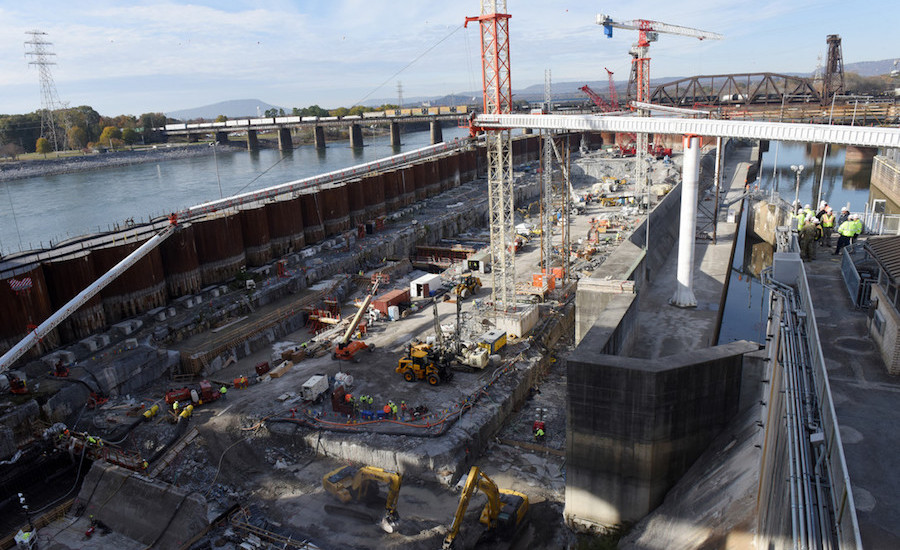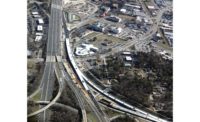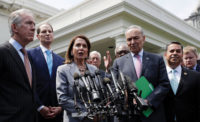President Trump has proposed a $1-trillion, 10-year infrastructure plan that, unlike an earlier proposal of his, would draw completely on federal funding. Administration officials haven’t yet identified how to raise the revenue to cover the entire $1-trillion price tag, however.
The White House unveiled the framework for the massive plan on Feb. 10, along with the president’s fiscal year 2021 budget request. [View White House fact sheet about infrastructure proposal here.]
The budget proposal would slash some important infrastructure accounts, including Army Corps of Engineers civil works and Environmental Protection Agency water infrastructure.
It also calls for some increases, including a huge jump for the General Services Administration’s program to construct new federal buildings.
Surface transport proposal
The heart of the $1-trillion infrastructure package would be an $810-billion, 10-year surface transportation reauthorization, which the White House and Dept. of Transportation outlined.
According to administration figures, highways, unsurprisingly, would account for the largest share, $602 billion, followed by transit, with $155 billion.
President Trump has publicly praised the five-year highway bill that the Senate Environment and Public Works Committee unanimously approved last July. It authorizes $287 billion for highways, compared with the $273 billion the administration's plan has for highways at the five-year mark.
House Democrats' framework would provide $329 billion for highways over five years.
Nicole Nason, head of the Federal Highway Administration, also applauded the Senate committee's bill. She told reporters in a conference call that DOT worked closely with the Senate panel and added, "We believe a 10-year proposal gives greater optionality for states for planning their projects."
But the Highway Trust Fund—the prime federal revenue stream for highways and transit—is $261 billion short of the amount needed to cover all of the administration's envisioned $810-billion, Joel Szabat, DOT’s acting under secretary for policy, said in the conference call.
DOT officials said detailed legislative language for the surface-transportation proposal was under review within the administration.
The non-surface transportation portion of the infrastructure package would total $190 billion, all in direct federal dollars.
That category would include $60 billion for new Building Infrastructure Great grants. Surface transportation projects would be eligible, along with projects in such sectors as ports, river locks and dams, drinking-water, waste treatment; energy and broadband.
Also contained in the $190 billion are $50 billion for freight-related highway, rail, port and waterway projects; and $35 billion for new bridge-rebuilding grants
The President's plan follows House Democrats’ Jan. 29 rollout of a $760-billion, five-year infrastructure package that goes well beyond surface transportation to include water resources, drinking water, energy and other sectors. Democrats also were silent on how to finance their blueprint.
“It is good that everyone is committed to investing in infrastructure, and understands its economic benefits,” says Brian Turmail, spokesman for the Associated General Contractors of America. “But all the good intentions aren’t going to amount to much, if people aren’t ready to have an honest, serious conversation about how to finance or fund the infrastructure.”
Turmail adds, “Otherwise, it’s just ‘Groundhog’s Day.’ We’re going to keep having the same conversations and to not make any decisions.”
As for Trump’s 2021 budget request, it is almost certainly a nonstarter in the Democratic-controlled House. Rep. Nita Lowey (D-N.Y.), the Appropriations Committee chairwoman, termed the proposal “a disastrous repeat of the misplaced priorities and callous cuts he has pursued unsuccessfully in past requests.”
Hike for federal highways
At DOT, some infrastructure accounts would fare well under the budget. [View DOT budget details here.] Notably, the core highway obligation ceiling would get an 8% increase over its enacted 2020 level, to just under $50 billion.
The Federal Transit Administration would be in line for a 2% increase, to $13.2 billion. But within that total, FTA’s Capital Investment Grants would be pared 4%, to $1.9 billio
The popular BUILD (formerly TIGER) discretionary grants would be frozen at $1 billion.
The administration also would zero out in 2021 some special DOT infrastructure accounts that draw on general funds in 2020. They include highway infrastructure programs, which are getting $3.3 billion this year, and general-fund airport grants, $400 million in 2020.
Trust-fund financed Airport Improvement Program infrastructure grants would be held level, at $3.35 billion.
Corps civil works targeted, again
In non-DOT agencies, the 2021 budget is a mix of up and down arrows. Dept. of Defense construction would be hit hard, with spending cut by 57%, to $7.8 billion.
Corps civil works also would be sliced deeply, with a proposed cut of $1.7 billion, or 22%.
Within that total, civil works construction would be sliced 19%, to $2.2 billion; and operation and maintenance would be chopped by 47%, to slightly less than $2 billion.
But the Corps’ many allies on Capitol Hill have routinely rejected past presidential requests to trim its civil works budget. John Doyle, special counsel with law and lobbying firm Jones Walker LLP, says of the 2021 proposal, “It’s going to be deader than dead on arrival.”
Doyle, a former senior Army civil-works official, points out that almost none of the requested construction funds would go for inland waterway lock and dam projects, even though major projects, such as the Kentucky River lock addition and a new Chickamauga lock on the Tennessee Rivers are “hundreds of millions of dollars underway.”
Also on the budget’s chopping block is EPA’s main water infrastructure program, state and tribal assistance grants. It would be slashed 33%, to $2.8 billion.
Within that total, Clean Water state revolving funds (SRFs), would face a 32% reduction, to $1.1 billion, and drinking water SRFs would be pared 23%, to $863 million.
Boost for GSA Construction
There were some bright spots, however. For example, GSA’s construction and acquisition account would get a more than fivefold boost, to $762 million, from this year’s unusually low $152-million level.
The big item on tap for 2021 is $459 million to continue work on the Dept. of Homeland Security’s new campus at the St. Elizabeths site in Washington, D.C.
GSA renovations would see a 63% increase, to $1.4 billion, including $209 million for a project at the Social Security Administration’s complex in Woodlawn, Md., near Baltimore.
Dept. of Veterans Affairs major-construction projects program would receive an 11% hike, to $1.4 billion, under the president’s plan.
Perhaps the highest-profile item in Trump’s budget request is the $2 billion he is seeking to continue work on the wall along the U.S.-Mexico border.
House Transportation and Infrastructure Committee Chairman Peter DeFazio (D-Ore.), a principal author of House Democrats' $760-billion infrastructure "framework," blasted Trump's budget for "gutting the Army Corps' budget by billions [and] slashing transit investments via the Capital Investment Grant program," among other provisions.
But DeFazio added in a statement that the administration's budget "signals he is interested in at least talking about the need to invest in our nation's crumbling infrastructure." He said, "But without further details, it's hard to say whether he is more interested in the status quo or whether he actually wants to move forward with innovative solutions...."
Story corrected on 2/11/20 to state that the Chickamauga Lock is on the Tennessee River, and to state that the Senate committee's highway bill totals $287 billion, not $278 billion.






Post a comment to this article
Report Abusive Comment